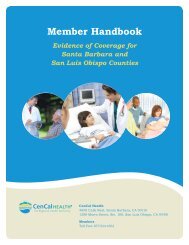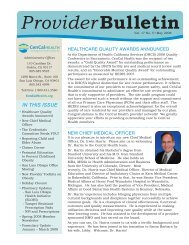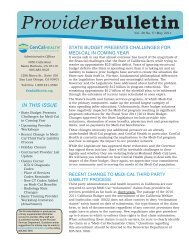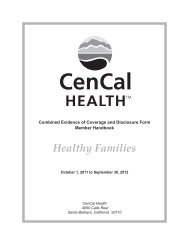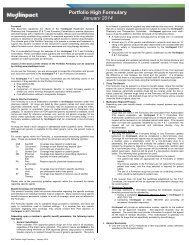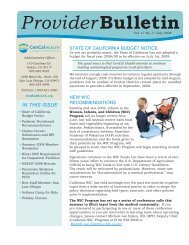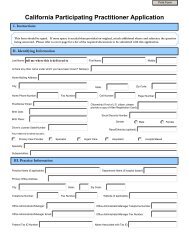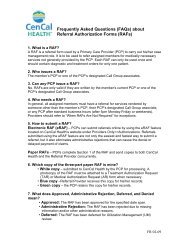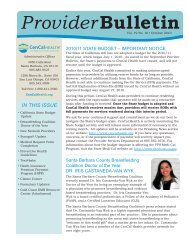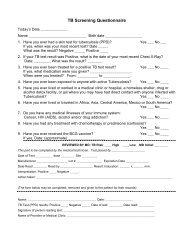Addressing Language Access Issues in Your Practice: A Toolkit for ...
Addressing Language Access Issues in Your Practice: A Toolkit for ...
Addressing Language Access Issues in Your Practice: A Toolkit for ...
Create successful ePaper yourself
Turn your PDF publications into a flip-book with our unique Google optimized e-Paper software.
7 CALIFORNIA ACADEMY OF FAMILY PHYSICIANS<br />
Determ<strong>in</strong><strong>in</strong>g current and future demand<br />
Know<strong>in</strong>g who lives <strong>in</strong> your catchment area and who your likely patient population will be <strong>in</strong> the future will also<br />
help you develop a language access strategy that makes long-term sense <strong>for</strong> your practice. There are several ways to<br />
get to know who your neighbors are and whom you may be serv<strong>in</strong>g over the next 5-10 years.<br />
• One way to judge who lives <strong>in</strong> your neck of the woods is to look at the demographic make-up of the geographical<br />
area that your practice serves. The 2000 U.S. Census has given us the opportunity to get this <strong>in</strong><strong>for</strong>mation with<br />
relative ease.<br />
American Factf<strong>in</strong>der is a web-based program that gives you immediate access to the data from the 2000 census.<br />
This site gives language demographics down to the census track level. Go to:<br />
http://www.census.gov/mp/www/spectab/languagespokenSTP224.xls, and click on CA (Cali<strong>for</strong>nia). Then scroll<br />
down to f<strong>in</strong>d the county and/or census track <strong>in</strong> which you are <strong>in</strong>terested. This chart will tell you the number of people<br />
who speak English less than “very well,” which can be taken as one measure of limited English proficiency.<br />
While this chart does not list the <strong>in</strong>dividual languages <strong>in</strong> as much detail as you might like, another chart does. On<br />
the same American Factf<strong>in</strong>der website, go to Summary File<br />
3, Table PCT10. This table lists languages spoken at home<br />
by <strong>in</strong>dividuals 5+-years-old, by state.<br />
• The Modern <strong>Language</strong>s Association has a language map<br />
based on data from the 2000 U.S. census that allows you to<br />
search <strong>for</strong> 30 different languages by state, county, city, and<br />
even zip code. Us<strong>in</strong>g the map is a bit cumbersome, because<br />
you have to search by each language separately, but it does<br />
give you a graphic view of where particular language populations<br />
are located. Aga<strong>in</strong>, not all of these speakers are<br />
necessarily LEP, but this map gives you an idea of the ethnic<br />
communities <strong>in</strong> your catchment area.<br />
http://www.mla.org.<br />
Know<strong>in</strong>g who lives <strong>in</strong><br />
your catchment area and<br />
who your likely patient population<br />
will be <strong>in</strong> the future<br />
will also help you develop a<br />
language access strategy ...<br />
• If you hear reference to a language among your patients that you’ve never heard of, try look<strong>in</strong>g it up on<br />
Ethnologue. This website gives an <strong>in</strong>dex to more than 6,000 world languages, <strong>in</strong>clud<strong>in</strong>g a description of each language<br />
and where it is spoken. http://www.ethnologue.com.<br />
• Another way to track the patient population that you may be serv<strong>in</strong>g <strong>in</strong> the future is to develop relationships<br />
with your state or local refugee resettlement organization who will be able to alert you when new refugee groups<br />
are arriv<strong>in</strong>g <strong>in</strong>to your geographic catchment area.<br />
• As you track speakers of <strong>for</strong>eign languages, don’t <strong>for</strong>get to also track the presence of the deaf and hard-of-hear<strong>in</strong>g<br />
population <strong>in</strong> your catchment area.<br />
Now you know who your current patients are, who your future patients could be, and whom you may likely be<br />
serv<strong>in</strong>g <strong>in</strong> the future. The next piece of <strong>in</strong><strong>for</strong>mation you need is what resources are available to help you meet the<br />
language needs of your LEP patients.



